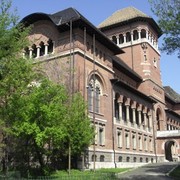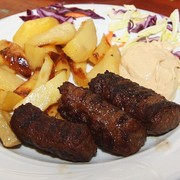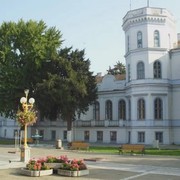Traditional Russia still existed; artists such as Konchalovsky, Machkov, Malevich (at the beginning of his career) were producing works in the classical style. Those artists, who were portraying a society genuinely linked to the foundation of Russian culture, intuitively sensed the profound changes to come.
This exhibition therefore begins in 1905, date of the first great change that took place in Russia’s history: the “Bloody Sunday” revolt in St. Petersburg. All these artists understood that an inevitable change in society was at hand, change that would soon lead to the 1917 October Revolution.
And in fact, the personal paths of these artists contributed to the changing spirit: they travelled abroad, they went to Paris—Baranoff-Rossin, Tatlin, Chagall and Kandinsky—they were all in quest of new ideas. For one, Konchalovsky was very interested by the work of Derain and Vlaminck; for another, Machkov probably saw and admired the work by Matisse. All these artists recognized the need to create a new style and these new ways of seeing became the very basis of this revolution—it started slowly and then became inevitable.
In contrast, other painters, writers and poets were far more advanced in their approach, fruit of the many exchanges between Russia and France. Matisse had just decorated the interior of the residence of Shchukin, a great collector who lived in Moscow. As Shchukin did with his home, so other private homes opened their doors every weekend in Moscow to display to a chosen public the works of Picasso, Braque and Gris that had been purchased in Paris by these rich industrialists. The artists discovered and invented new forms, new colors, a new way of seeing the world. Marinetti, an Italian poet and a born revolutionary, came to give conferences in the Russian capital and sketched out what would be the very foundation of an important pictorial revolution.
Art bore witness to this new world, taking into account a period, which was changing. Progress was ineluctable. It became accepted that a car could be as beautiful as a painting. And if the car is in movement, well then art can also embrace such movement. The machine inevitably creates innovation, and so new artistic schools appeared, changed by dreams and utopias. Larionov, Goncharova and Udaltsova began to express themselves by borrowing ideas from the FrenchCubists. They had been to see them or seen their works exhibited in Moscow, they had sometimes worked in their studios or the work of those French artists had been acquired by Russian collectors. Russian artists took inspiration from what they saw and in turn created an extraordinary nucleus, a genuine fermentation of new ideas leading to the founding of different artistic movements: that of Rayonism with Larionov and Goncharova, that of Futurism around David Burliuk. For the first time, associating a fixed image from Cubism to an image in movement from Futurism gave rise to a typically Russian movement: Cubo-Futurism.
Other artists such as Chagall, who was unconnected to any school, gave expression to other dreams. Chagall’s work spoke of tradition coming from old Russia. He painted other images, inspired by the Orient, using other colors. His work, using themes of Jewish culture, was in a whole new style all his own and furnished a new substrata to history that was in the process of being created. The Theater of Jewish Art, painted in 1920 after the 1917 Revolution had already broken out, is a meaningful example of Chagall’s new way of representation.
Chagall was named director of the Vitebsk school in 1917 and returned to the country where he was born (known now as Belorussia). He created a school there at the request of Lunacharsky, minister of culture. Naturally he put into practice the tenets of a new way of thinking, of seeing, of writing, of painting. He brought in other important artists who were following other artistic paths such as Lissitsky and Malevich.
Creating his own language, Malevich brought in new ideas, turning upside down the poetic vision of Chagall’s work. The Suprematist school that Malevich founded soon became an obstacle to any possible understanding with Chagall. The rupture was inevitable.
Chagall left for Moscow to create the Theater of Jewish Art, that extraordinary place where all the great artists of his time would come to participate in exercising their arts: writers, poets, directors, actors. Chagall created this fresco, Introduction to the Theater of Jewish Art (which is eight meters long), an astounding painting that proves to what extent he remained faithful to that Russian and Jewish culture which is the very basis of his inspiration. As for Malevich, he continued to embody a language completely opposite of Chagall’s but one just as extraordinary: he created abstract art, an artistic expression totally unknown until then and which compelled attention. And so a new school came into being-- Suprematism.
At the same time, other artists such as Tatlin created another school using new materials, that of Constructivism. The exhibition of the Grimaldi Forum sheds light on this opposition and complementarity between Suprematism and Constructivism. The artists who participated in that particular part of history such as Rodchenko, Tatlin, Kliun, Rozanova, Popova and many others, participated also in that revolution of the spirit. In Russia in the twenties, the thirst for change originated in and existed side by side with the new modernity.
From the start of the Revolution, Kandinsky, who at the beginning of the 20th century had developed his own innovative style, was in charge of a commission to distribute to museums in the provinces the work of all those artists who were considered as revolutionaries and who worked and exhibited in Moscow and St. Petersburg. The State bought works that were sent to Rostov-on-the Don, to Perm, to Astrakhan and Krasnodar etc….to ensure that the heart of Russia would discover the revolutionary message.
Rapidly, those in power began to distort this noble message, permeating it with ideology whose motivations did not necessarily correspond to the liberty of style of the artists.
The latter finally understood that they could no longer exercise their rights as creators in an environment where ideas were being imposed upon them. Many of them left Russia beginning in the 1920s and moved to Berlin, Paris and the United States: Larionov, Goncharova, Kandinsky, Chagall, Baranoff-Rossin. Confronted by a Russian art that had become more and more official, imposing its vision upon the artists, those who remained behind such as Malevich were “prisoners.” And so he wrote, “I prefer a sharp pen to a dishevelled brush.” They would return to figurative painting, though of figures devoid of faces. As for Filonov, he closed himself off into a completely different language, impenetrable to any understanding by the revolutionaries in power.
The death of Mayakovsky in 1930, emblematic poet of the Revolution, marked the end of an exceptional and unique adventure, the end of dreams and of utopias…
[Read also the first article about this subject].
https://www.youtube.com/watch?v=hhI506CCgqw%20
https://www.youtube.com/watch?v=XbnNQNNvQ5Y%20https://www.youtube.com/watch?v=XbnNQNNvQ5Y %20


































